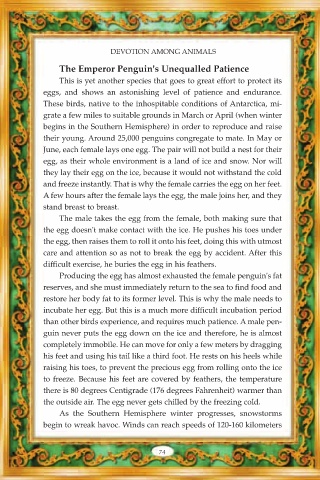Page 76 - Devotion Among Animals Revealing the Work of God
P. 76
DEVOTION AMONG ANIMALS
The Emperor Penguin's Unequalled Patience
This is yet another species that goes to great effort to protect its
eggs, and shows an astonishing level of patience and endurance.
These birds, native to the inhospitable conditions of Antarctica, mi-
grate a few miles to suitable grounds in March or April (when winter
begins in the Southern Hemisphere) in order to reproduce and raise
their young. Around 25,000 penguins congregate to mate. In May or
June, each female lays one egg. The pair will not build a nest for their
egg, as their whole environment is a land of ice and snow. Nor will
they lay their egg on the ice, because it would not withstand the cold
and freeze instantly. That is why the female carries the egg on her feet.
A few hours after the female lays the egg, the male joins her, and they
stand breast to breast.
The male takes the egg from the female, both making sure that
the egg doesn't make contact with the ice. He pushes his toes under
the egg, then raises them to roll it onto his feet, doing this with utmost
care and attention so as not to break the egg by accident. After this
difficult exercise, he buries the egg in his feathers.
Producing the egg has almost exhausted the female penguin's fat
reserves, and she must immediately return to the sea to find food and
restore her body fat to its former level. This is why the male needs to
incubate her egg. But this is a much more difficult incubation period
than other birds experience, and requires much patience. A male pen-
guin never puts the egg down on the ice and therefore, he is almost
completely immobile. He can move for only a few meters by dragging
his feet and using his tail like a third foot. He rests on his heels while
raising his toes, to prevent the precious egg from rolling onto the ice
to freeze. Because his feet are covered by feathers, the temperature
there is 80 degrees Centigrade (176 degrees Fahrenheit) warmer than
the outside air. The egg never gets chilled by the freezing cold.
As the Southern Hemisphere winter progresses, snowstorms
begin to wreak havoc. Winds can reach speeds of 120-160 kilometers
74

